This Spring, our first-ever Artist In Residence Stacey Walyuchow worked with community members to tell their stories through creative art. People of all ages from East Village, Connaught, and beyond have created visual art and poetry about their experiences in community, and what that word means to them.
These artworks are on display at Village Commons as an installation, and are also featured in the Common Unity Chapbook. Read about a few pieces here, and visit Village Commons to see each artwork in all its glory and pick up a limited copy of the chapbook for yourself.
Thanks to the City of Calgary and Calgary Housing Company for their support of this project, and to Stacey Walyuchow for leading the way!
 What Is A Community?
What Is A Community?
by Connaught School Grade 3 and Grade 4 students
Students shared that a community is a place of happiness, a place where we play and learn, where our family and friends are, and where we belong. Using their choice of media including embroidery, origami, watercolour and pastels, students shared an image which symbolized community for them. The images include: dark sky, gardens, rainbows, fences, family, pets and their home. Together, their artwork shines in the greater collaboration of our grade 3 and 4 classroom.

Our Village
by Rosemary Griebel
I work in East Village and have been walking through the community for over thirty years. During this time there has been incredible change, yet the spirit of the community has endured. This is where Calgary was founded and has been a place of gathering and welcome for Indigenous peoples for over 10,000 years. It is a place of story and generosity, work and learning, doctrine and doubt. It is a place that welcomes the destitute and the wealthy; a place that takes risks of trust. My poem celebrates this diverse and resilient community
Our Village
Our village was once an open field
embraced by two blue rivers.
Home to jackrabbits, skittery hawks and coyotes.
Home to tipis, fire warmth and shared stories.
Later, came humble houses and hotels,
tumble down shops and places of worship.
These streets bright with invisible history.
In our village grace and sorrow have always held hands,
and every table has room for one more plate.
Here, my friend – eat, drink. Feed on kindness.
We don’t know why we share this world, only that we do.
We are all wildlings, all promise here.
Take my hand. Together we are community.
– Rosemary Griebel
 Sea of Sisters 2.0
Sea of Sisters 2.0
by Madiha Madda
Muslim women, whether they know each other or not, commonly refer to each other as “Sister.” This practice comes from the idea that we all belong to the same faith community. This mixed-media collage was created to authentically represent the richness of local Muslim women, and to pay homage to some of the sisters I have met during my time in Calgary. Several of these women are still a part of my life, while others have drifted in and out, like waves in the sea. Each one of these women have contributed in memorable and meaningful ways to my story. They have showed up for me during my darkest times; they have celebrated with me; they inspire me, and they challenge me to grow. I am honoured to learn from them, love them and call them my sisters.
 If a Community Loses its Last House, Will Stories Remain?
If a Community Loses its Last House, Will Stories Remain?
by Lisa Murphy Lamb
East Village is a neighbourhood with many pasts and yet, it is a community that looks confidently to the future with new high rises, amenities, hope and excitement. Do we know on whose land we live? What business or home once made up the block we walk along? Were there any families in the East Village or was it merely blocks of rooming houses and working hotels? How will we know the stories if we can’t stop and wonder at a repurposed building or discuss the architecture of a century old home? There are no longer any single dwelling houses remaining once the Sanders
Residence came down by way of a bulldozer in 2019. If walls can talk and now they’re gone, will stories of the the East Village past, the people who lived and worked and passed through remain?
If a Community Loses its Last House, Will Stories Remain?
Who will talk about the cup ring left on a maple table
will never be known the reason the letter remained
unfinished documents belonged to who
swept the penny into the corner?
Jiggle the key to unlock the door each morning
a man with a briefcase left exactly at 7:12 through mahogany
mink winter hat on his head after days
with stomach flu made himself scrambled
eggs in the kitchen while robins sang outside
the house
which stood for a century +
a carton of milk on the counter can you imagine
a potted orchid, an industrious mouse scratching
across the checkered linoleum a bouquet of flies gathering
on window ledges
had an air of the wild west
about the cost to build $600 in the Early Settlement period
and closets held sweaters, elbows worried through secret
Lady Di scrapbooks
and lace up boots
– Lisa Murphy Lamb
 The Mobile Market
The Mobile Market
by Kum Mee Oh
Once a week the Mobile Market with their truck loaded with fruits and vegetables will make a stop in East Village, to sell their goods to the residents here. The whole sale prices they charged were affordable and they also sold in small quantities that would appeal to seniors, small families, students, and people on limited income. For example, a loaf of bread cost only $1, two bananas were 70 cents or 2 onions for maybe 60 cents. It was all very reasonable and affordable and easy for seniors to carry their purchases back to their apartments.
